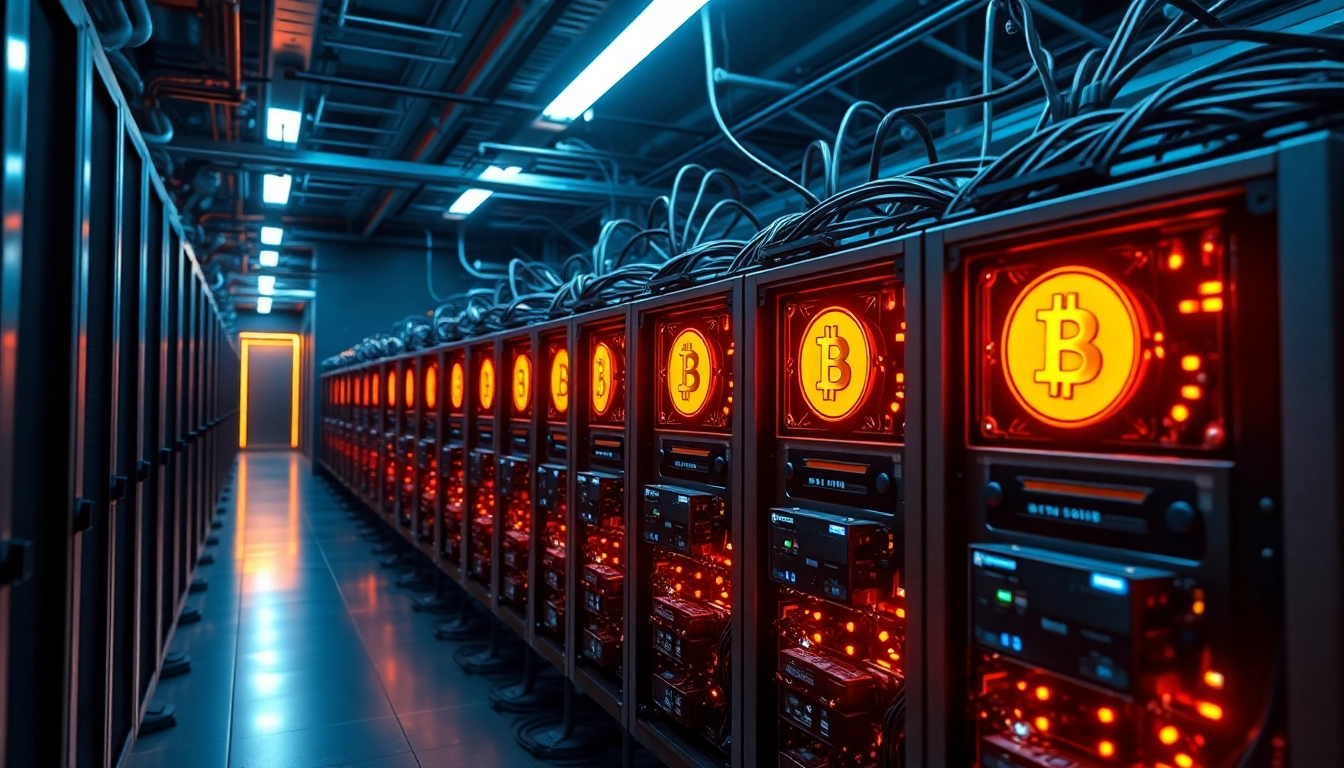Understanding Bitcoin Mining Basics
Bitcoin mining is a critical process that underpins the very foundation of the Bitcoin network. It is the method by which new bitcoins are created and transactions are confirmed on the blockchain. Essentially, it involves using powerful computers to solve complex mathematical problems, which, in turn, secures the network and processes transactions. For those looking to dive deep into the world of cryptocurrencies, understanding Bitcoin mining is essential. This guide will explore the intricacies of Bitcoin mining, from its basic concepts to more advanced strategies for maximizing efficiency.
What is Bitcoin Mining?
Bitcoin mining refers to the process of validating transactions and adding them to the blockchain, Bitcoin’s public ledger. This process requires significant computational power, as miners engage in solving cryptographic puzzles that secure network operations. Once a miner successfully solves a puzzle, they broadcast the solution to the network, and if confirmed by other miners, they receive a reward in the form of new bitcoins and transaction fees.
In simpler terms, Bitcoin mining can be likened to a competitive lottery, where miners use powerful hardware to compete against one another to be the first to validate a block of transactions. The winner is rewarded with bitcoins, and the cycle continues indefinitely, with the difficulty of the puzzles adjusting approximately every two weeks to ensure that blocks are mined roughly every ten minutes.
How Bitcoin Mining Works
At its core, Bitcoin mining relies on the principles of cryptography and decentralized network governance. Here’s an overview of how the process works:
- Transaction Initiation: Users initiate Bitcoin transactions, which are then compiled into blocks by miners.
- Proof of Work: Miners compete to find a hash that meets the Bitcoin network’s current target. This requires substantial computational effort and energy, leading to the term ‘proof of work.’
- Block Validation: Once a miner solves the puzzle, the new block is validated by other miners to ensure its accuracy.
- Chain Update: The validated block is added to the existing blockchain, and the miner receives a block reward plus transaction fees.
As more users join the network and increase the transaction volume, the mining difficulty adjusts to maintain equilibrium in block creation, typically aiming for an average of one block every ten minutes.
The Importance of Bitcoin Mining in the Blockchain
Bitcoin mining serves several crucial functions in the blockchain ecosystem:
- Transaction Security: By verifying transactions, miners ensure that the network remains secure and resistant to fraud and double-spending.
- Network Decentralization: Mining helps maintain the decentralized nature of the Bitcoin network, as no single entity controls the blockchain.
- New Bitcoin Creation: Mining is the only way to introduce new bitcoins into circulation, thereby controlling the supply and contributing to its overall scarcity.
Setting Up Your Bitcoin Mining Operation
Essential Equipment for Bitcoin Mining
Setting up a Bitcoin mining operation begins with acquiring the right hardware. The primary equipment includes:
- ASIC Miners: Application-Specific Integrated Circuit (ASIC) miners are specialized hardware designed solely for the purpose of mining. They offer significant advantages in terms of efficiency and power compared to traditional GPUs.
- Power Supply: Given that mining consumes considerable energy, an adequate power supply is critical to sustain operations without interruptions.
- Cooling Systems: High-performance mining equipment generates a lot of heat, necessitating effective cooling solutions to prevent overheating and potential hardware failures.
Choosing the Right Mining Software
In addition to hardware, mining software plays an essential role in facilitating the mining process. The mining software connects miners to the Bitcoin network, managing the process of receiving work, submitting completed work, and monitoring performance statistics. Some popular mining software options include:
- CGMiner: One of the most widely used mining software, CGMiner is an open-source tool that supports various operating systems and offers numerous customizable options.
- BFGMiner: BFGMiner is similar to CGMiner but is specifically optimized for ASIC devices.
- EasyMiner: This user-friendly software employs a graphical interface and is an excellent option for beginners.
Selecting a Suitable Mining Pool
For individual miners, mining solo can be daunting due to the high competition and considerable computing power required. Joining a mining pool, a group of miners who combine their computational resources, can provide more consistent rewards. When choosing a mining pool, consider factors such as:
- Pool Fee: Different pools have varying fee structures, typically around 1% to 3% of the rewards.
- Size of the Pool: Larger pools may provide more reliable and frequent payouts but could also mean lower individual rewards due to shared efforts.
- Payout Structure: Some pools offer more favorable payout systems, such as Pay Per Share (PPS) or Pay Per Last N Shares (PPLNS), which can significantly affect overall earnings.
Maximizing Efficiency in Bitcoin Mining
Best Practices for Energy Management
Energy consumption is one of the most significant expenses in Bitcoin mining. To maximize profitability, miners should implement the following best practices:
- Optimal Location: Establishing mining facilities in regions with cheaper electricity rates can drastically reduce operational costs.
- Renewable Energy Sources: Utilizing renewable energy sources such as solar or wind can mitigate electricity expenses and reduce the carbon footprint of mining operations.
- Efficient Cooling: Invest in efficient cooling technologies, like liquid cooling or evaporative cooling systems, to minimize energy usage while maintaining optimal hardware performance.
Optimizing Mining Hardware Performance
Beyond energy management, optimizing the performance of mining hardware is essential for maximizing output. Strategies include:
- Overclocking: Many miners choose to overclock their ASIC hardware to boost performance, but this also increases power consumption and heat generation. Proper monitoring and cooling measures are essential.
- Regular Maintenance: Routine checks and maintenance of mining rigs can prevent performance degradation. Tasks like cleaning dust and ensuring connections are secure can prolong hardware lifespan.
- Firmware Updates: Keeping mining hardware firmware up-to-date can enhance efficiency and address potential bugs that might affect performance.
Monitoring Mining Profitability
Understanding the profitability of mining operations is paramount. Miners should utilize various tools and calculators available online to assess their expected revenue against electricity costs, pool fees, and hardware expenses. Keeping track of market prices for Bitcoin and potential changes in mining difficulty can help miners adapt their strategies for maintaining profitability.
Bitcoin Mining Security and Challenges
Common Security Threats to Bitcoin Miners
While Bitcoin mining is generally secure, miners face specific threats that they need to be aware of:
- 51% Attacks: If a group of miners controls more than 50% of the network’s computational power, they could potentially manipulate transactions and compromise security. This highlights the importance of decentralization in mining.
- Malware and Hackers: Miners are also targets for malicious attackers who may attempt to steal mining rewards or compromise hardware. Utilizing robust security practices, including regular software updates and antivirus measures, is essential.
Regulatory Challenges in Bitcoin Mining
As Bitcoin grows in popularity, regulatory scrutiny has also increased. Miners must navigate potential regulations that could impact their operations, such as:
- Licensing and Compliance: Some jurisdictions require licenses to operate mining facilities, and non-compliance can result in penalties or shutdowns.
- Environmental Regulations: As the environmental impact of mining comes under scrutiny, regulators might impose environmental standards on energy consumption and emissions, pushing miners towards more sustainable practices.
Dealing with Market Volatility
The price of Bitcoin is notorious for its volatility, which can impact mining profits significantly. Miners should consider strategies to mitigate risks related to market fluctuations, such as:
- Diversification: Some miners choose to diversify by mining multiple cryptocurrencies, thus reducing reliance on a single asset.
- Hedging: Using financial instruments like futures contracts can help miners hedge against price drops, ensuring more stable returns.
The Future of Bitcoin Mining
Emerging Technologies in Bitcoin Mining
The landscape of Bitcoin mining is continuously evolving, and several emerging technologies hold promise for the future of the industry:
- Quantum Computing: Although still in its infancy, quantum computing could potentially revolutionize mining efficiency by vastly increasing processing power. However, it also poses existential threats due to its potential to break current cryptographic methods used in securing the blockchain.
- AI Optimization: Artificial intelligence can assist miners in optimizing their operations, predicting market changes, and streamlining processes for greater efficiency.
Impact of Regulation on Bitcoin Mining
Regulatory pressure will likely continue to shape the future of Bitcoin mining. Countries that offer supportive regulatory frameworks may attract mining investments, while those that enforce stringent regulations could drive mining activities underground or to more favorable jurisdictions. Miners must remain agile and informed about regulatory changes to strategize effectively.
Sustainable Practices in Bitcoin Mining
As sustainability becomes an increasing focus globally, Bitcoin mining is shifting towards more environmentally friendly practices. This includes:
- Utilizing Renewable Energy: Many miners are investing in renewable energy sources to reduce their carbon footprint and operational costs.
- Carbon Offsetting: Some mining operations are exploring carbon credit programs to compensate for their emissions.
The future of Bitcoin mining will be defined by how well the industry adapts to challenges and embraces sustainable practices, ensuring its viability in a rapidly changing world.












